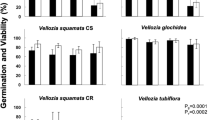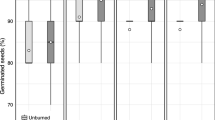Abstract
To analyse the potential reaction to firegenerated heat pulses, seeds of 12 species of plants and rhizomes of three species were exposed to elevated temperatures for 10 min. The tested material split into three groups with respect to heat tolerance: (1) the rhizomes, for which the lethal temperatures were in the range 55–59° C; (2) the seeds of most of the species tested, for which the lethal temperatures were in the range 65–75° C; (3) The seeds of two species of Leguminosae and three species of Geranium for which the lethal temperatures were around 100° C. For all three Geranium species and for one of the legume species, Anthyllis vulneraria, exposure temperatures above ca. 45° C resulted in dormancy release, and maximum germination occurred above 60–65° C. Speed of germination was little affected for most species, except after exposure to nearlethal temperatures, where it slowed down dramatically, although the seedlings emerging were healthy. We conclude that due to sharp temperature gradients in the soil during fire, differences in heat tolerance between species in most cases are not large enough to be a decisive factor in their post-fire colonising success. There are exceptions: the seeds of certain taxa that are impermeable to water in the dormant state, some of which have heat triggered germination.
Similar content being viewed by others
References
Ahlgren CE (1960) Some effects of fire on reproduction and growth of vegetation in Northeastern Minnesota. Ecology 41:431–445
Ahti TL, Hämet-Ahti L, Jalas J (1968) Vegetation zones and their sections in northwestern Europe. Ann Bot Fenn 5:169–211
Archibold OW (1980) Seed input into a postfire forest site in northern Saskatchewan. Can J For Res 10:129–134
Baker FS (1929) Effect of excessively high temperatures on coniferous reproduction. J For 27:949–975
Bjor K (1972) Micro-temperature profiles in the vegetation and soil surface layers on uncovered and twig covered plots. Rep Norw For Res Inst 30:199–218
Brooker DB, Bakker-Arkema FW, Hall CW (1974) Drying cereal grains. AVI Publishing company, Westport, Connecticut
Dahlgren K (1943) Svedjenävan (Geranium bohemicum) och brandnävan (Geranium lanuginosum). Sven Bot Tidskr 37:127–160
Flinn MA, Wein RW (1977) Depth of underground plant organs and theorethical survival during fire. Can J Bot 55:2550–2554
Floyd AG (1966) Effects of fire on weed seeds in wet sclerophyll forests of northern New South Wales. Aust J Bot 14:243–256
Frandsen WH (1987) The influence of moisture and mineral soil on the combustion limits of smoldering forest duff. Can J For Res 17:1540–1544
Granström A (1982) Seed banks in five boreal forest stands originating between between 1810 and 1963. Can J Bot 60:693–709
Granström A (1988) Seed banks at six open and afforested heathland sites in southern Sweden. J Appl Ecol 25:297–306
Grime JP, Mason G, Currtis AV, Rodman J, Band SR, Mowforth MAG, Neal AM, Shaw S (1981) A comparative study of germination characteristics in a local flora. J Ecol 69:1017–1059
Hägglund B, Lundmark JE (1977) Site index estimations by means of site properties. Scots pine and Norway spruce in Sweden. Stud For Suec 138
Hanna PJ (1984) Anatomical features of the seed coat of Acacia kempeana (Mueller) which relate to increased germination rate induced by heat treatment. New Phytol 96:23–29
Heinselman ML (1981) Fire and succession in the conifer forests of northern North America. In: West DC, Shugart HH, Botkin BD (eds) Forest succession. Springer, New York, pp 374–405
Hillel D (1980) Introduction to soil physics. Academic Press, London
Hobbs RJ, Gimingham CH (1984) Studies on fire in Scottish heathland communities. I. Fire characteristics. J Ecol 72:223–240
Jalas J (1950) Zur Kausalanalyse der Verbreitung einiger Nordischen Os- und Sandpflanzen. Ann Bot Soc Zool Bot Fenn 24:1–362
Keeley JE, Morton BA, Pedrosa A, Trotter P (1985) Role of allelopathy, heat and charred wood in the germination of chaparral herbs and suffrutescents. J Ecol 73:445–458
Koppenaal RS, Colombo SJ (1988) Heat tolerance of actively growing, bud-initiated, and dormant black spruce seedlings. Can J For Res 18:1103–1105
Lyon LJ, Stickney PF (1976) Early vegetal succession following large Northern Rocky Mountain wildfires. Tall Timbers Fire Ecology Conf 14:355–375
Mallik AU, Gimingham CH (1985) Ecological effects of heather burning. II. Effects on seed germination and vegetative regeneration. J Ecol 73:645–656
Martin RE, Miller RL, Cushwa CT (1975) Germination response of legume seeds subjected to moist and dry heat. Ecology 56:1441–1445
Ohmann LF, Grigal DF (1981) Contrasting vegetation responses following two forest fires in Northeastern Minnesota. Am Midl Nat 106:54–64
Porsild AE, Cody WJ (1980) Vascular plants of continental Northwest Territories, Canada. National Museums of Canada, Ottawa
Risberg B (1991) Nägra fynd av svedjenäva i Torsåker. Sven Bot Tidskr 85:169–170
Roberts EH (1988) Temperature and seed germination. In: Long SP, Woodward FI (eds) Plants and temperature. (Symposia of the Society for Experimental Biology 42). Society for Experimental Biology, Cambridge, pp 109–132
Rowe JS (1983) Concepts of fire effects on plant individuals and species. In: Wein RW, MacLean DA (eds) The role of fire in northern circumpolar ecosystems. Wiley, New York, pp 135–154
Sandberg DV (1980) Duff reduction by prescribed underburning in Douglas fir. US For Ser Res Pap PNW272
Tutin TG, Heywood VH, Burges NA, Valentine DH, Walters SM, Webb DA (1964–1980) Flora Europaea I–V. Cambridge University Press. London
Uggla E (1957) Mark och lufttemperatur vid hyggesbränning samt eldens inverkan på vegetation och humus. Norrl Skogsvårdsförb Tidskr 4:443–500
Vasander H, Lindholm T (1985) Fire intensities and surface temperatures during prescribed burning. Silva Fenn 19:1–15
Vuillemin J, Bulard C (1981) Ecophysiologie de la germination de Cistus albidus et C. monspeliensis. Nat Monspel 46:1–11
Wright HA (1970) A method to determine heat-caused mortality in bunchgrasses. Ecology 51:582–587
Zackrisson O (1977) Influence of forest fires on the north Swedish boreal forest. Oikos 29:22–32
Author information
Authors and Affiliations
Rights and permissions
About this article
Cite this article
Granström, A., Schimmel, J. Heat effects on seeds and rhizomes of a selection of boreal forest plants and potential reaction to fire. Oecologia 94, 307–313 (1993). https://doi.org/10.1007/BF00317103
Received:
Accepted:
Issue Date:
DOI: https://doi.org/10.1007/BF00317103




